Physical Address
304 North Cardinal St.
Dorchester Center, MA 02124
Acknowledgments: I would like to acknowledge Kenneth R. Means, Jr., and Thomas J. Graham for their sixth edition version of this chapter. A special thank you goes to Sameer Shetty, MS, for his help in the preparation of the eighth edition of this chapter.
The elbow, forearm, and wrist act as a unified structure to provide a stable, strong, and highly mobile unit for positioning the hand in space and for performing load-bearing tasks. Understanding the relevant anatomy and biomechanics is essential for the surgeon who treats disorders of the forearm axis.
The ulna is the primary “load-bearing” bone of the forearm and supports the radius as it rotates during pronation and supination. The ulna is essentially straight and suspends the radius through stabilizing ligaments at the wrist, at the elbow (proximal radioulnar joint [PRUJ]), and in the midshaft. The radius has an anterior bow allowing it to rotate around the ulna. Just proximal to the tuberosity of the radius, the bone is oriented exactly parallel to the axis of rotation of the forearm and lies at a 15-degree angle relative to the shaft of the radius. This configuration allows the radius to line up and articulate in a congruent fashion at the PRUJ. It is worth noting that malalignment of the PRUJ is relatively well tolerated and does not have much effect on forearm rotation. Conversely, malalignment of the distal radioulnar joint (DRUJ) has a major effect on pronation and supination. This is due to the fact that the distal radius has to swing in three planes to rotate about the ulnar head. The longitudinal axis of forearm rotation passes through the center of the radial head at the elbow and through the fovea of the ulnar head at wrist level ( Fig. 21.1 ). This axis is not constant but changes slightly as the radial and ulnar heads shift on their respective articular surfaces during pronation and supination. With pronation the radial head moves into a position that is anterior and medial on the capitellum. With supination the head moves into a position that is lateral and posterior.
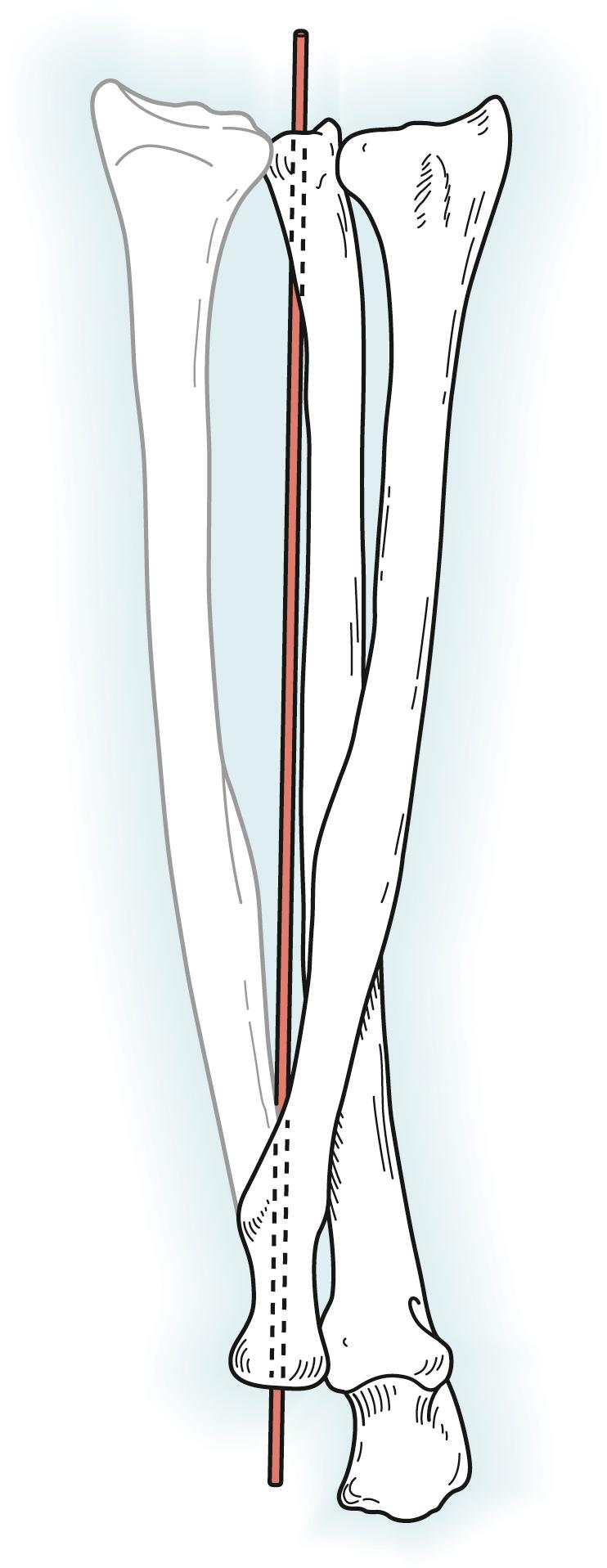
Forearm rotation occurs between the radial head and the radial notch of the ulna proximally (PRUJ) and between the ulnar head and the sigmoid notch of the radius distally (DRUJ). These joints act as hemijoints in facilitating forearm rotation. In addition, the component parts of the interosseous membrane (IOM) act to stabilize the radius on the ulna during forearm rotation and loading (as well as presenting an expanded surface from which certain muscles take origin). The IOM has distal, middle, and proximal portions, together constituting an integrated mechanism constraining the relative movements of the radius and ulna. The condensations within the membrane that appear to have the greatest mechanical strength are the distal oblique band, the central and accessory bands, the dorsal oblique accessory cord, and the proximal oblique cord ( Fig. 21.2 ). Forearm rotation is a complex motion with rotational and translational elements. Injuries and inflammatory conditions can disrupt the seamless relationship between the forearm structures.
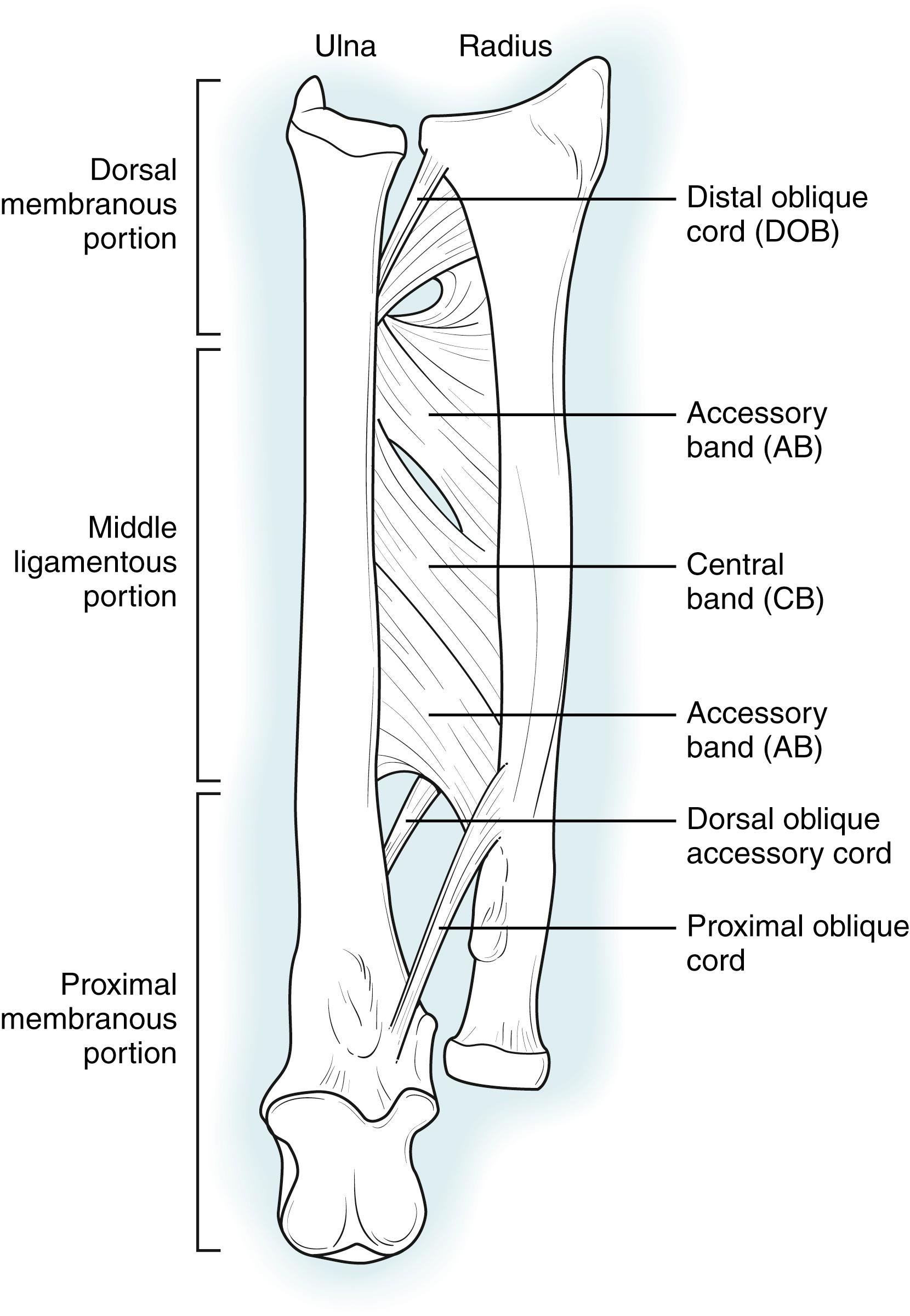
This chapter focuses on pertinent anatomy and biomechanics, as well as operative techniques for adult disorders, including radial shaft fractures, middle and distal ulnar shaft fractures, both-bone fractures of the forearm, removal of radial and ulnar shaft plates, nonunion and malunion of the radius and ulna, radioulnar synostosis, and longitudinal instability of the forearm.
Fractures of the radial shaft may be isolated or may be more extensive and have significant associated soft tissue involvement, as seen on radiographic views. The unique “bowed” osseous anatomy of the radius, supported between the stable PRUJ and DRUJ, makes it vulnerable to direct trauma through its diaphysis. Transmission of forces created by a fall on the outstretched hand may lead to a global forearm injury. Because of the unique anatomy, any deviation in the spatial orientation of the radius can decrease forearm rotation. Restoration of motion requires acceptable axial and rotational alignment in addition to the maintenance of the radial bow.
The concept of the forearm as a ring helps direct the evaluation and treatment of all forearm fractures. High-energy injuries can disrupt the ligaments supporting the DRUJ or PRUJ. As such, it is judicious to examine the entire extremity. This includes the neurologic and vascular systems.
Imaging should begin with frontal and lateral radiographs of the entire forearm with a low threshold to obtain views of the wrist and elbow. Computed tomography (CT) or magnetic resonance imaging (MRI) is not typically necessary in the initial assessment of acute forearm shaft fractures. For more complex injuries, however, CT can help one understand the degree of comminution and the location of additional fracture lines for preoperative planning. CT can also be useful in evaluating the extent of healing following open reduction and plate fixation.
Neurovascular structures are vulnerable to trauma and to surgical treatment of forearm fractures and dislocations ( Fig. 21.3 ). As the radial nerve enters the forearm, it divides into the deep posterior interosseous nerve and the superficial sensory, or dorsoradial sensory, nerve. The posterior interosseous nerve (PIN) passes anterior to the elbow capsule and enters the supinator. The PIN crosses the proximal radius 5 to 6 cm distal to the radiocapitellar joint before exiting the supinator ( Figs. 21.4 and 21.5 ). This nerve is particularly vulnerable to injury in this region from trauma or in the course of the surgical exposure of the proximal radius ( Fig. 21.6 ). The PIN provides motor fibers, in succession, to the extensor carpi radialis brevis (ECRB), supinator, extensor digitorum communis (EDC), extensor digiti minimi, extensor carpi ulnaris, abductor pollicis longus, extensor pollicis longus (EPL), extensor pollicis brevis (EPB), and extensor indicis proprius. The nerve terminates as a proprioceptive sensory nerve to the wrist. The superficial sensory branch of the radial nerve travels beneath the brachioradialis and emerges between the brachioradialis and extensor carpi radialis longus (ECRL) tendons approximately 8 cm proximal to the radial styloid. ,
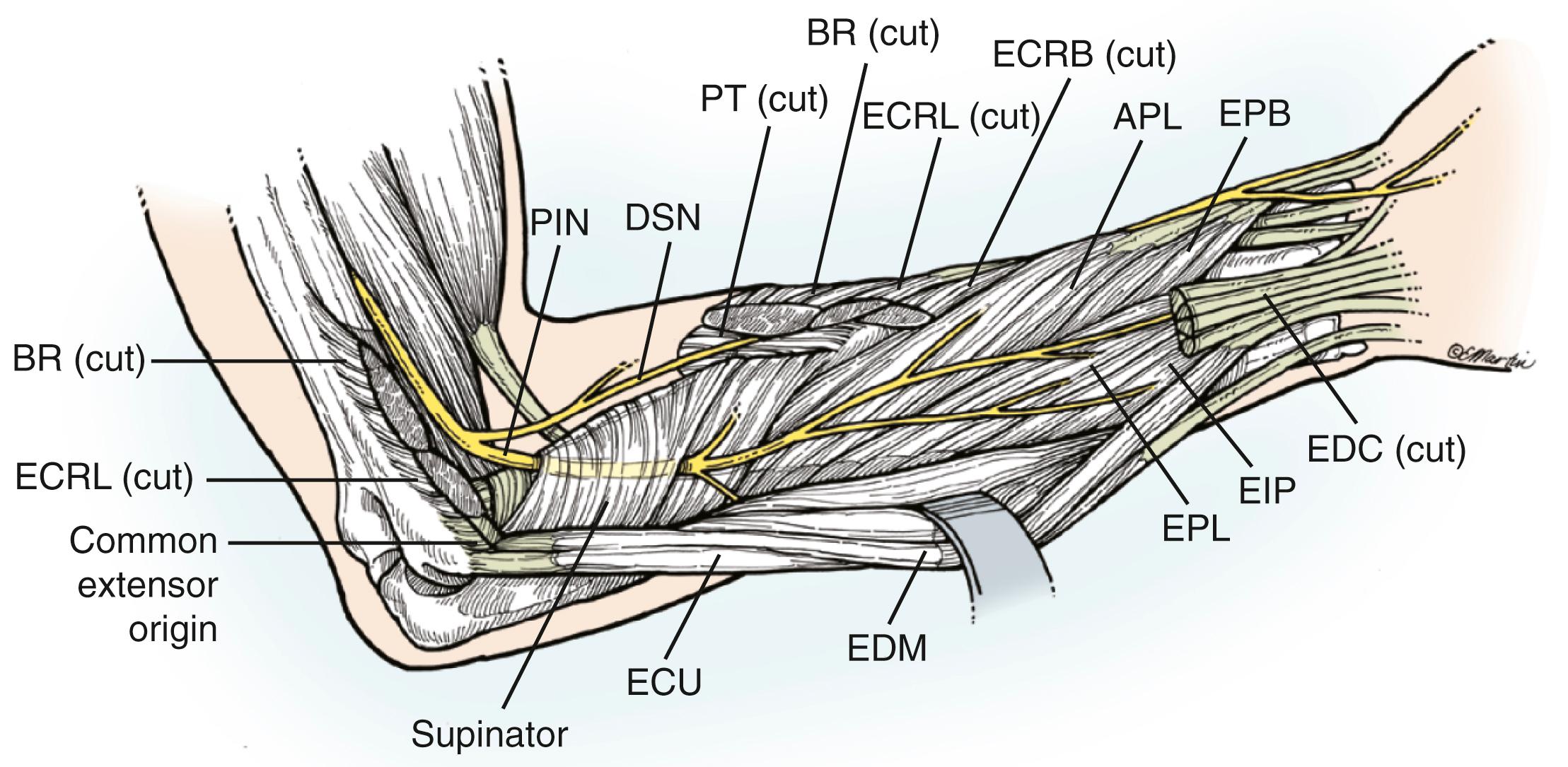
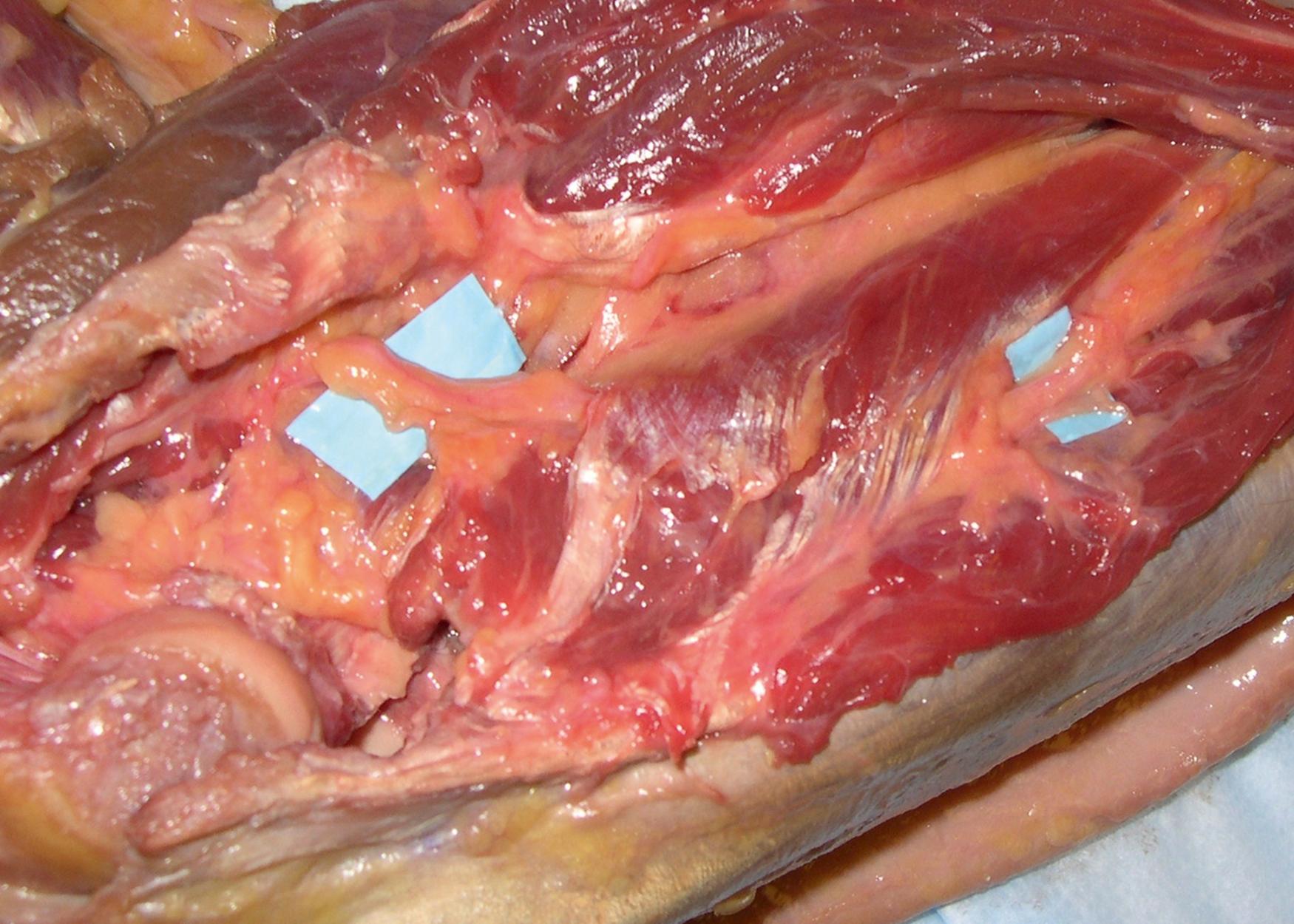
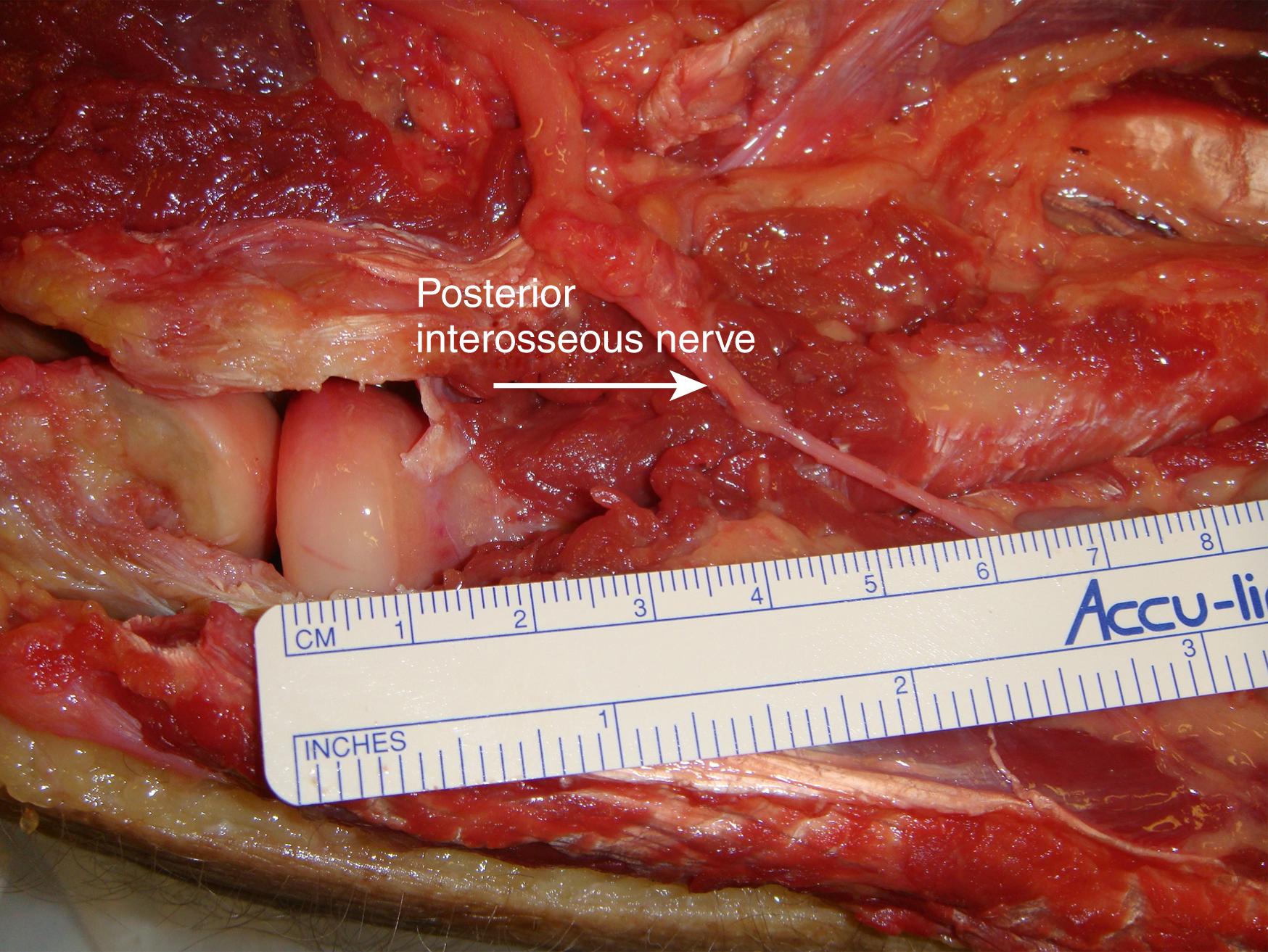
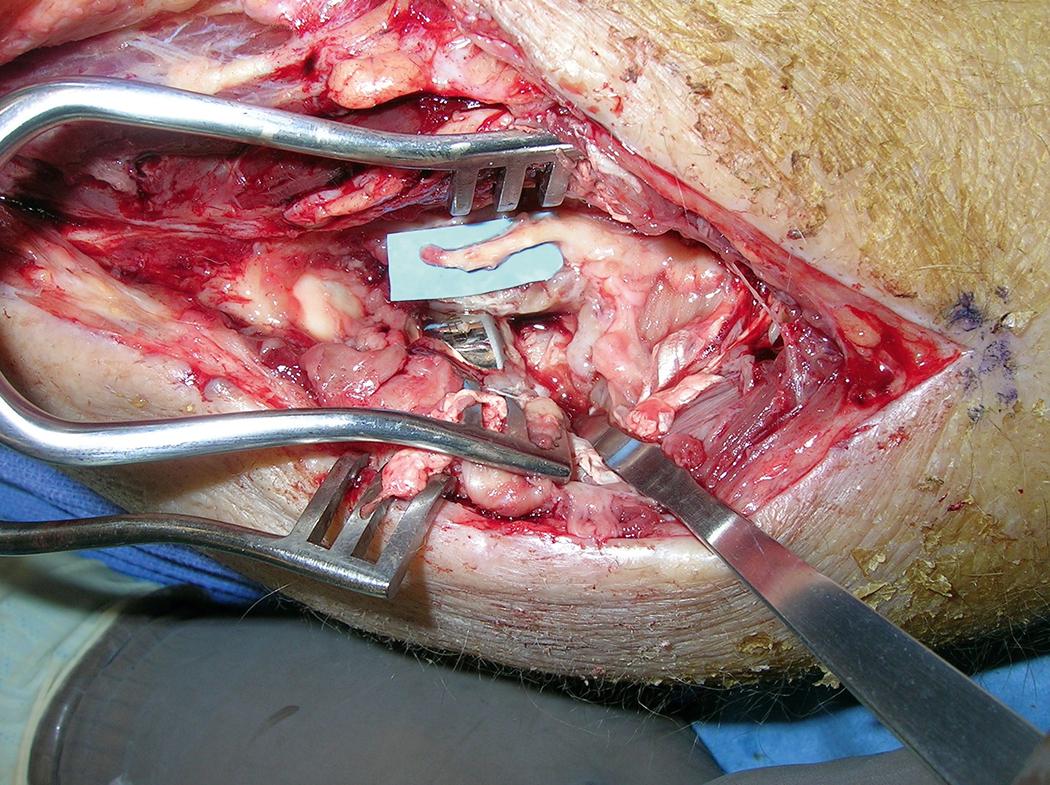
After entering the forearm beneath the bicipital aponeurosis, the median nerve travels between the two heads of the pronator teres. The anterior interosseous nerve is a branch that emanates just proximal to the flexor digitorum superficialis (FDS) and then passes between the two heads of this muscle. The median nerve proper continues distally in the forearm between the FDS and flexor digitorum profundus (FDP) until it enters the carpal tunnel, passing beneath the palmaris longus. The palmar cutaneous nerve branches from the median nerve in the distal part of the forearm, approximately 8.5 cm proximal to the distal volar wrist crease. It runs between the flexor carpi radialis and palmaris longus, deep to the forearm fascia. It pierces the fascia approximately 4.5 cm proximal to the volar wrist crease.
The radial and ulnar arteries branch from the brachial artery after it exits beneath the bicipital aponeurosis. The radial artery continues into the forearm beneath the brachioradialis until it reaches the distal end of the forearm, where it immediately becomes a subfascial structure.
Understanding of the osseous morphology of the radius, especially the anterior bow in the diaphysis, helps the surgeon when treating radius fractures or malunions. This is especially true with comminuted fractures and injuries with segmental bone loss. As discussed, the radial bow is crucial to pronation and supination because it allows the radius to rotate about the ulna. The radial bow is assessed on a frontal radiograph with the forearm in neutral rotation, the shoulder abducted 90 degrees, and the elbow flexed 90 degrees. The radial bow can be defined by drawing a line between the radial tuberosity proximally and the most ulnar edge of the radius distally. A perpendicular line is drawn at the point of maximal radial bow, and the length of this line is measured ( Fig. 21.7 ).
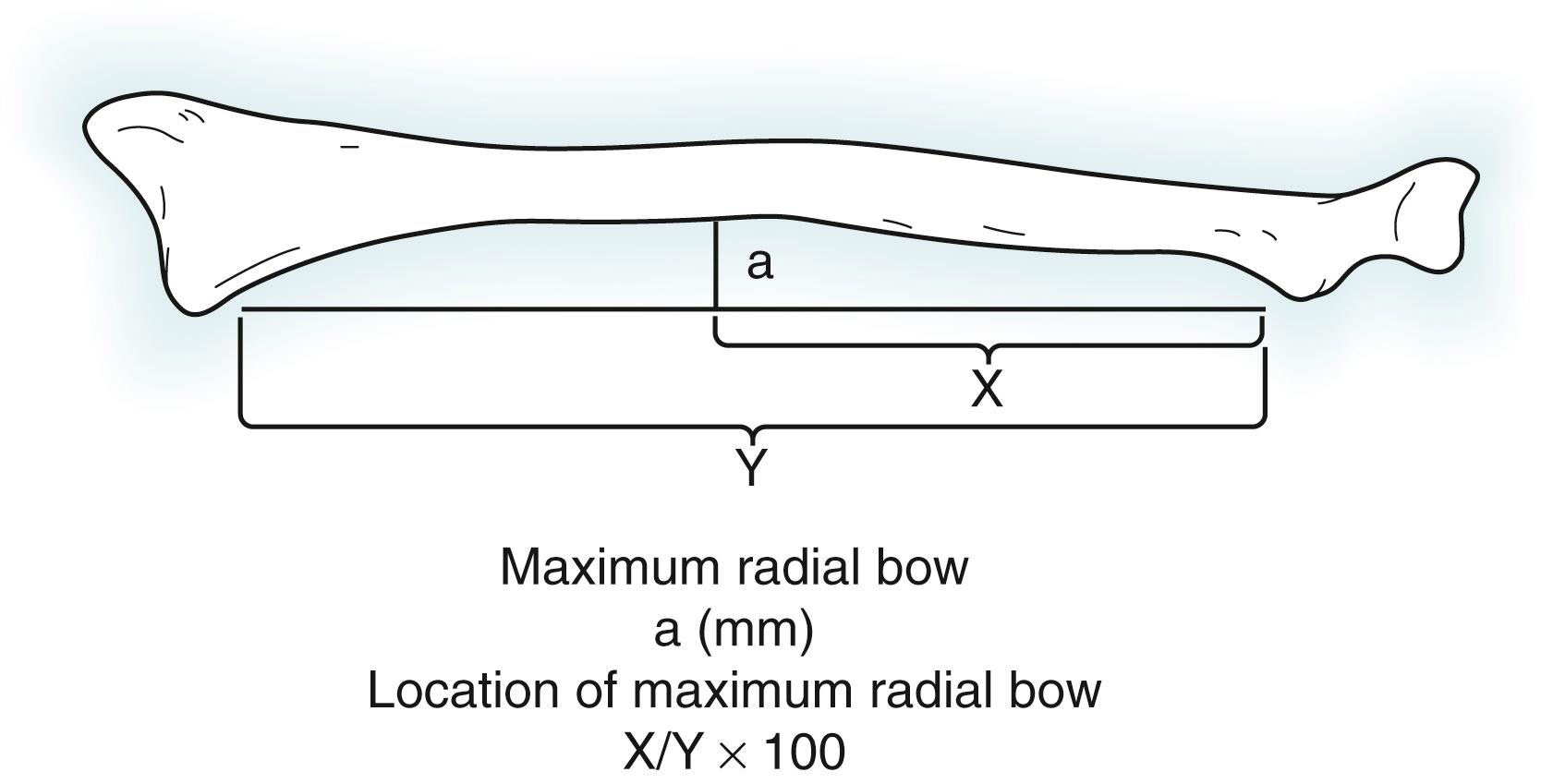
There are several advantages to the anterior approach to the radial shaft, also known as the “volar approach of Henry.” The entire radius may be exposed with this approach, from the radial head proximally to the radial styloid distally. The anterior approach to the radial shaft is indicated for practically any fracture involving the radius. There are well-defined intervals for the exposure that permit hardware to be placed on the anterior surface of the radius while still providing excellent muscle and soft tissue coverage. During the anterior approach, “blind” placement of curved retractors around the proximal radial shaft should be performed, with care taken to avoid injury to the PIN.
The patient is placed supine on the operating room table. A radiolucent arm board is placed under the injured extremity. All potential pressure areas are well padded. General or regional anesthesia is appropriate. Prophylactic intravenous antibiotics are administered when surgical implants are anticipated. A nonsterile tourniquet padded with a cotton roll is applied to the upper part of the operative extremity.
An incision of varying length, determined by the longitudinal extent of the fracture, is made on the anterior and radial aspect of the forearm by using a line extending from the lateral aspect of the distal biceps tendon to the radial styloid ( Fig. 21.8 ). The incision is centered on the site of the fracture and extended proximally and distally to allow reduction and fixation without undue retraction on the skin edges or underlying structures. The fascia of the anterior forearm musculature is incised longitudinally, just ulnar to the brachioradialis, which may be seen just deep to the fascia. Once the fascia is opened, the radial artery can be identified ulnar to the brachioradialis. The interval between the radial artery and the brachioradialis is developed ( Fig. 21.9 ), and arterial branches to the brachioradialis are ligated or cauterized. In the distal third of the forearm, the radial artery will be clearly distinct and ulnar to the brachioradialis. More proximally, the radial artery lies deep to the brachioradialis. When mobilizing the brachioradialis radially, the superficial sensory branch of the radial nerve should be identified deep to the brachioradialis and protected. It is mobilized radially with the brachioradialis ( Fig. 21.10 ).
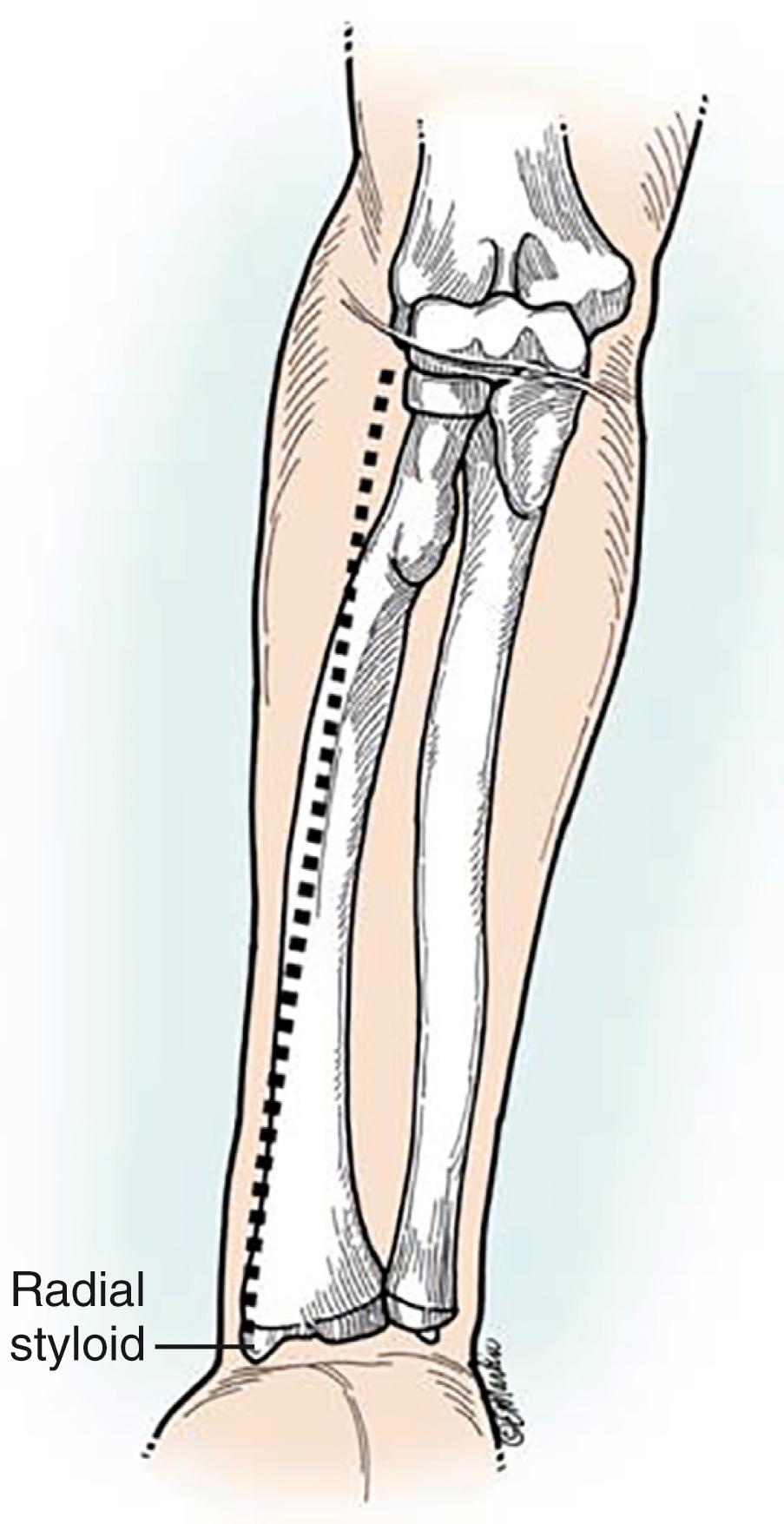
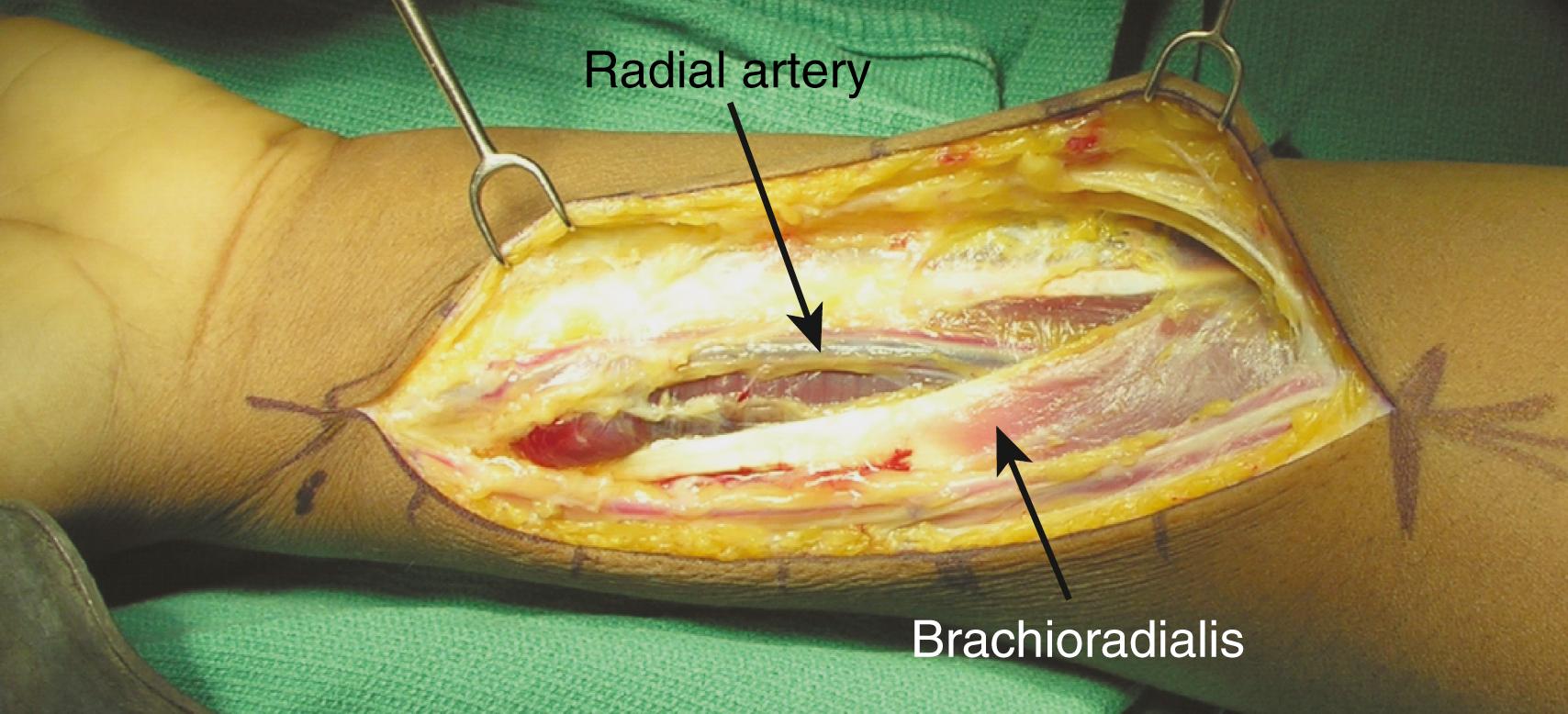
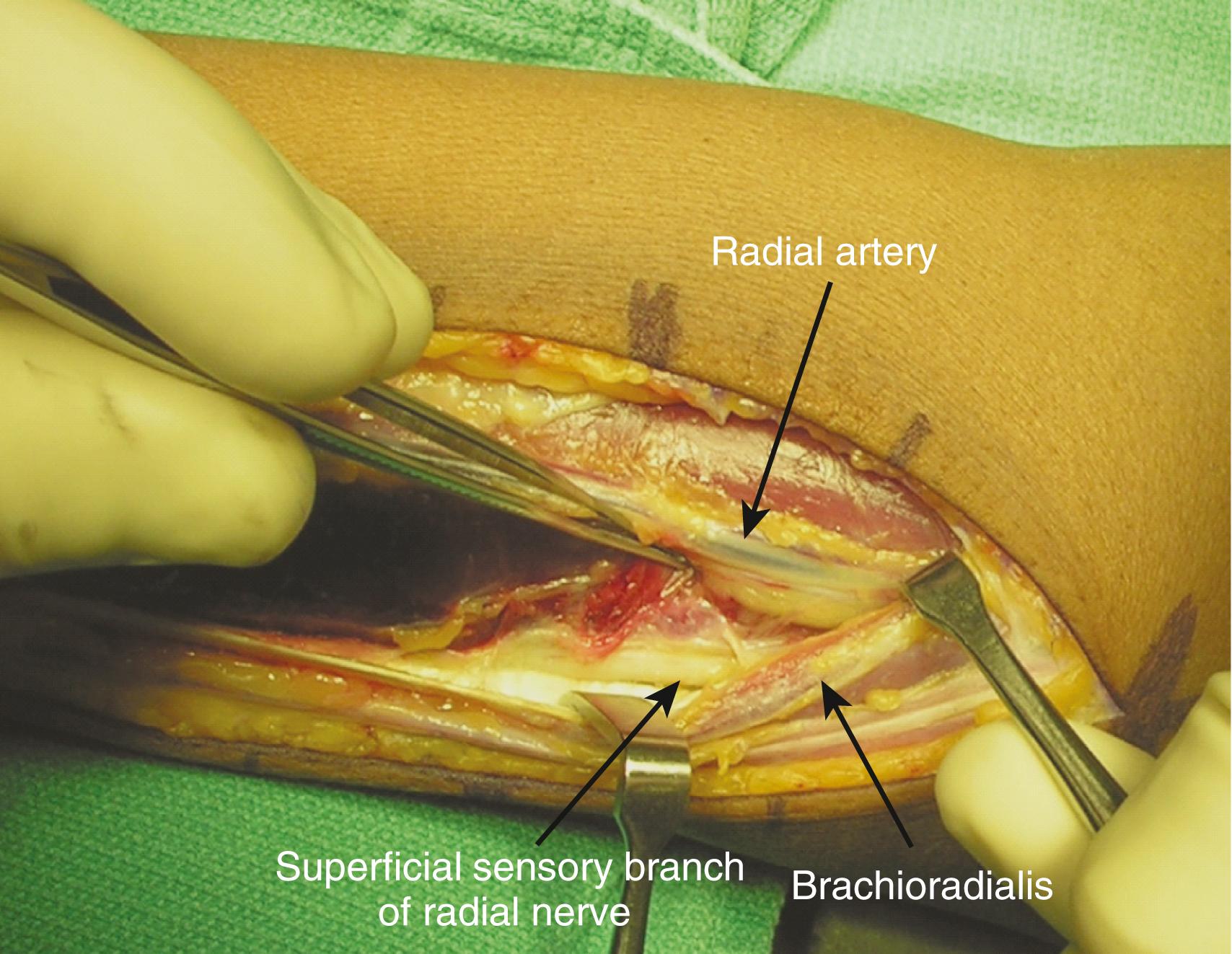
Deep dissection differs proximally and distally. In the proximal third of the forearm, the lateral antebrachial cutaneous nerve should be identified and protected as it exits between the brachioradialis and the distal biceps muscle. Next find the insertion of the biceps tendon. Just lateral to it, there is a small bursa. An incision is made in the bursa. The radial artery at this level is medial and superficial to the biceps tendon, so dissection is safe lateral to the tendon. It is more difficult to mobilize the brachioradialis radially as it travels obliquely across the forearm. By staying lateral to the distal biceps tendon, the brachioradialis and radial artery are separated. The recurrent branch of the radial artery is usually seen at this level and may need to be divided to allow adequate exposure. Supination of the forearm reveals the supinator muscle. The supinator is elevated in a subperiosteal plane in an ulnar to radial direction ( Fig. 21.11 ). Because the PIN may lie directly on the posterior aspect of the radial shaft at this level, subperiosteal dissection does not necessarily ensure that the nerve has been elevated and is protected. For this reason, the anterior portion of the radius is exposed only in a supinated position. Curved retractors or other instruments should not be placed around the posterior aspect of the radial shaft at this level. Once the interval between the brachioradialis and the radial artery is developed, the pronator teres is visualized and divided at its radial insertion. The pronator is elevated in a radial to ulnar direction to expose the radial shaft. In the distal third of the forearm, the interval between the radial artery and the flexor carpi radialis may be used. The flexor pollicis longus and pronator quadratus muscles are dissected off of the radial shaft in a radial to ulnar direction to expose the shaft.
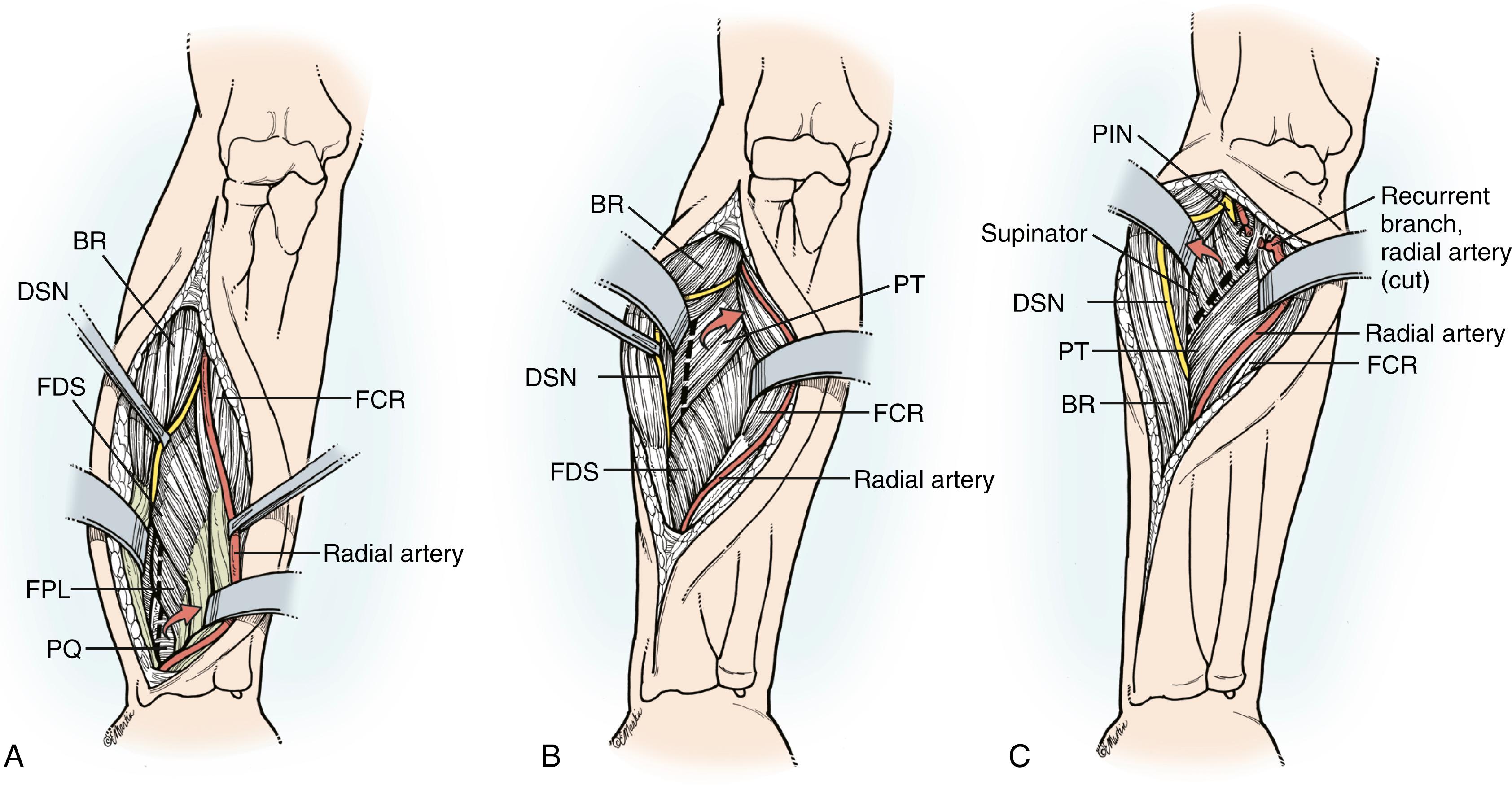
The posterior approach to the radial shaft (Thompson approach) is used primarily for proximal fractures. This approach requires that the surgeon identify the PIN. The entire radius can be exposed when working between muscle intervals.
The patient is placed supine on the operating table. The arm may be placed on an arm board or across the patient’s chest. With the forearm pronated, an incision is made just anterior to the lateral epicondyle and proceeding distally toward the middle of the wrist ( Fig. 21.12 ). The incision is carried through the subcutaneous tissue. The interval between the ECRB and the EDC is identified ( Fig. 21.13 ). Once the dissection is deep to those muscles, the supinator is immediately apparent. The radial nerve is within the substance of the muscle and should be dissected, mobilized, and protected. Distally, the abductor pollicis longus and EPB (first extensor compartment muscles) emerge from between the EDC and the ECRB, making the interval more identifiable at this level ( Fig. 21.14 ). Immediately deep to the EDC-ECRB interval proximally is the supinator muscle belly. The PIN is identified as it enters the supinator muscle proximally. The nerve is dissected through the length of the supinator by dividing its superficial head. Once the nerve has been identified and protected, the supinator is elevated off of the radial shaft in an anterior to posterior direction. The shaft is now exposed, and reduction and stabilization can proceed. The abductor pollicis longus and EPB cover the radius near the junction of the middle and distal third of the shaft and may be elevated proximally or distally as needed. Distal to this level, the interval is between the ECRB and the EPL, or it can be shifted between the EPL and EDC if exposure is required more distally.
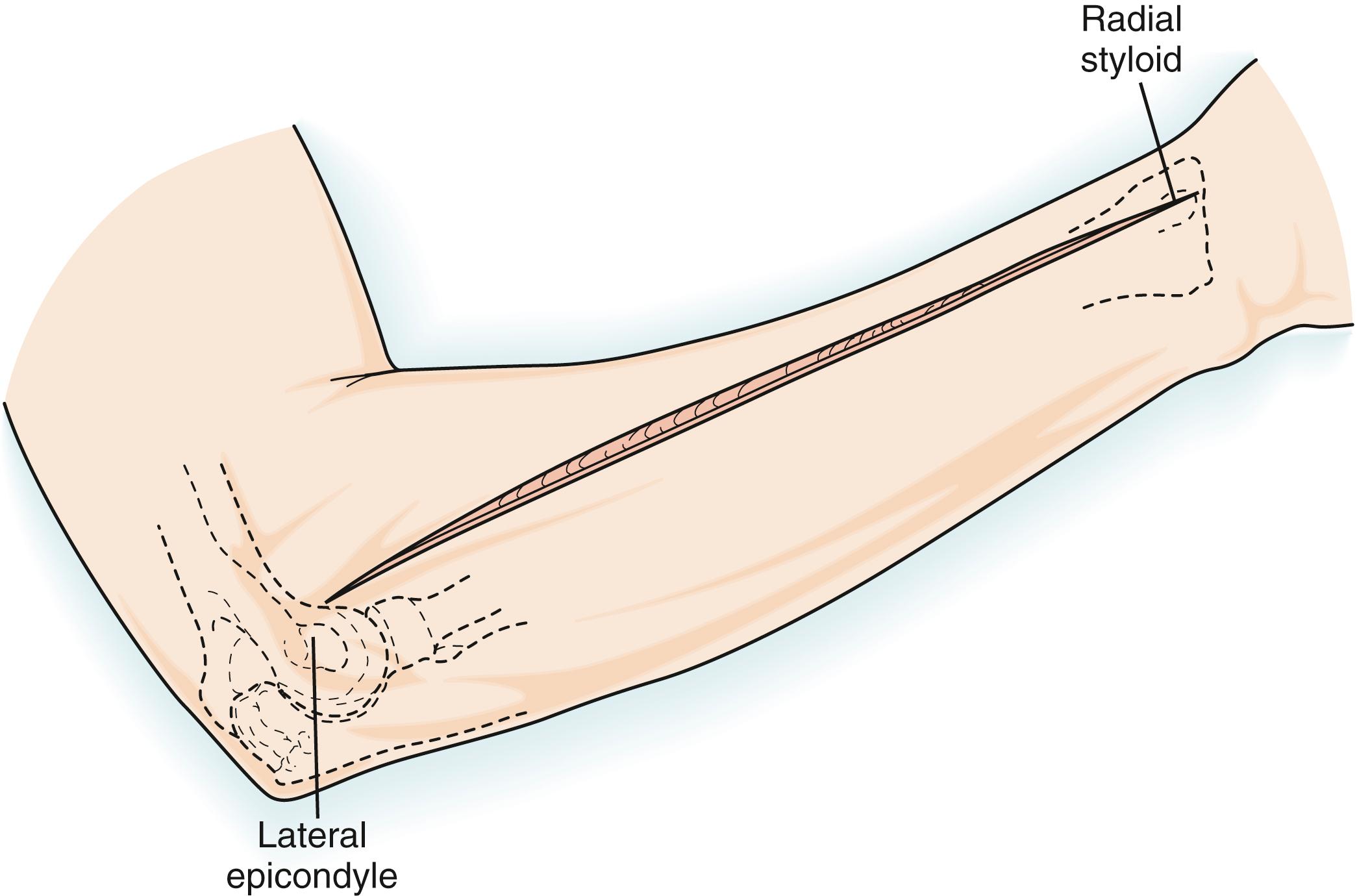
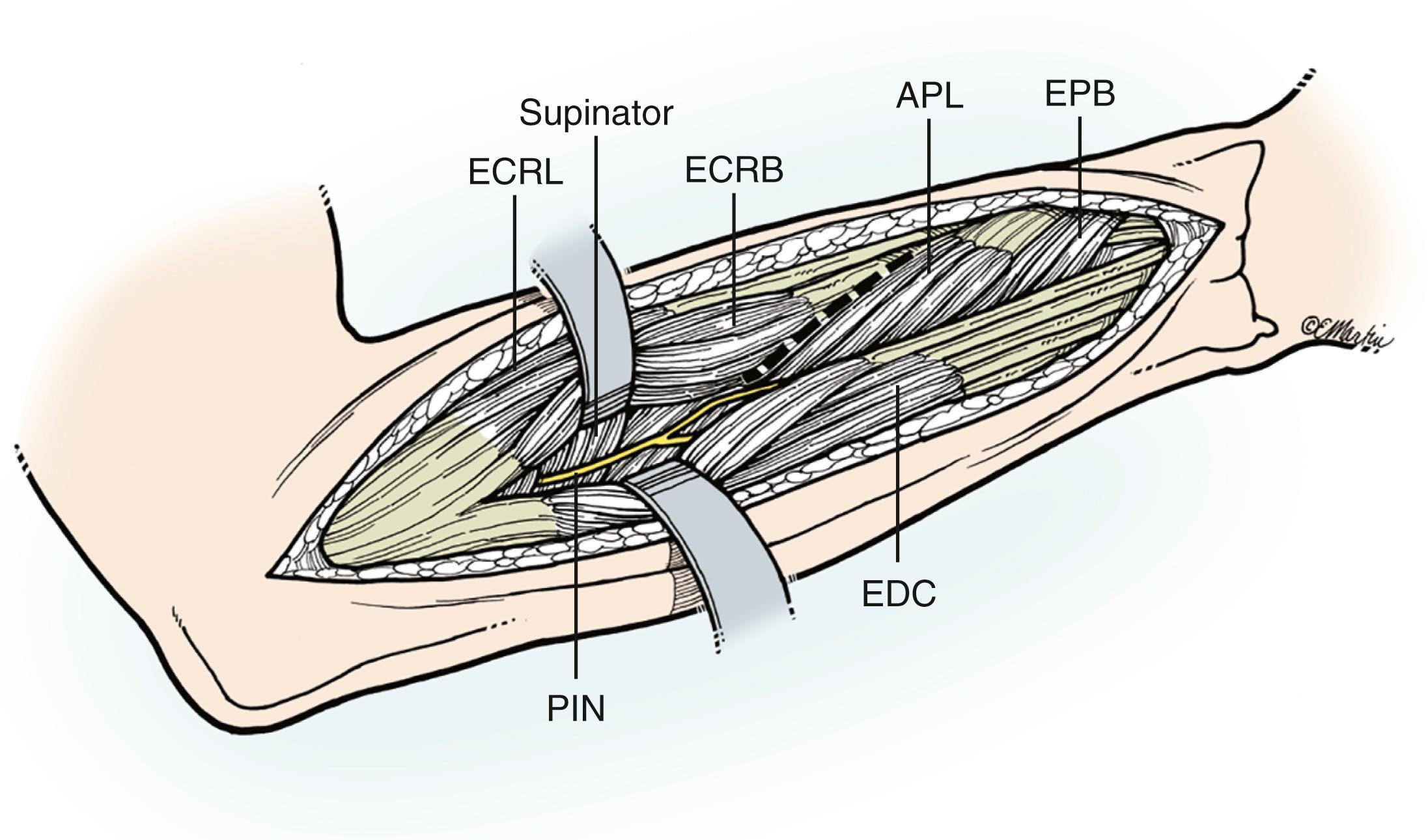
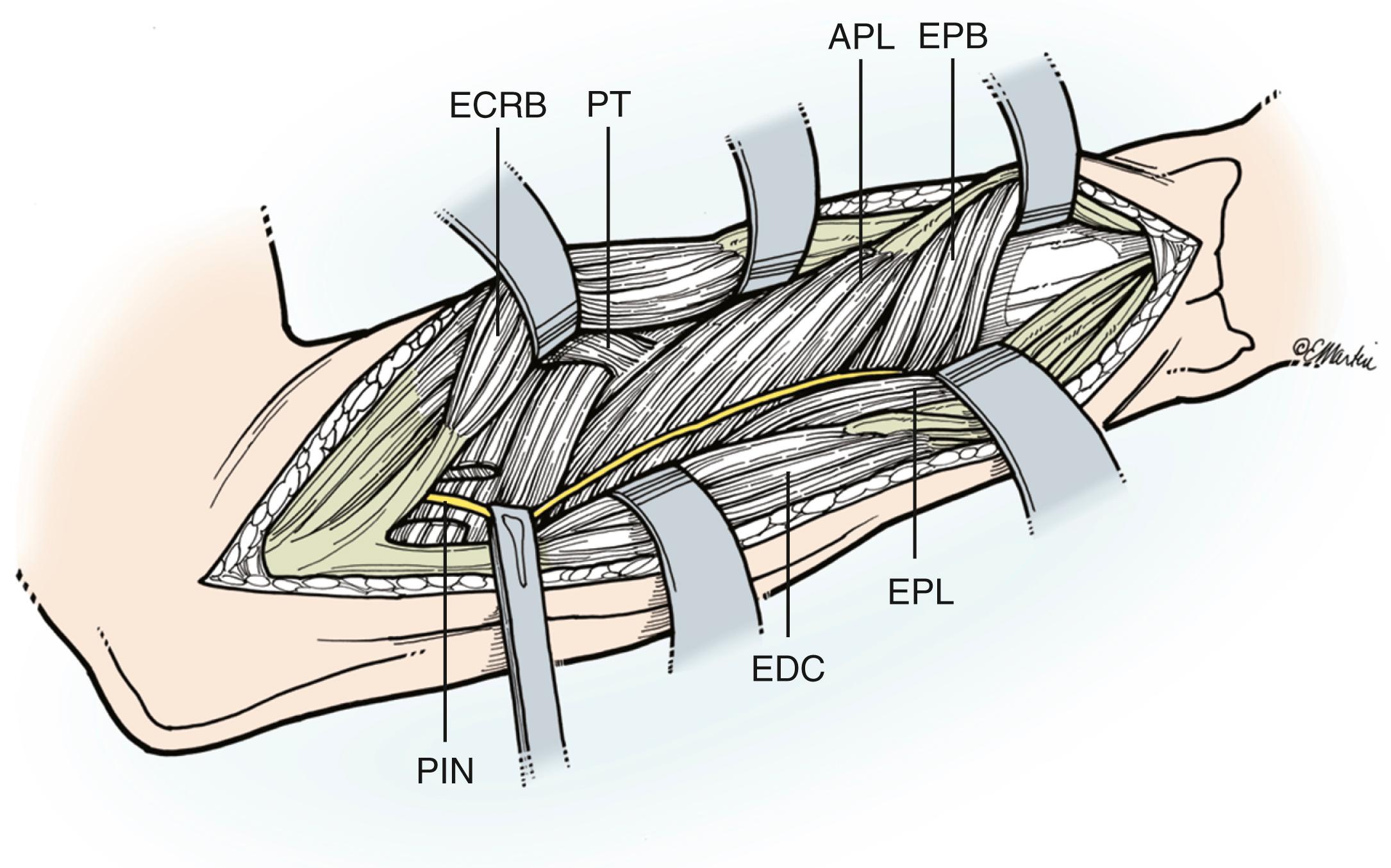
Conventional wisdom has suggested that optimal fixation of radial shaft fractures consists of compression plating with a 3.5-mm plate and screws engaging five or six cortices proximal and distal to the fracture ends. , Recent studies have demonstrated a high union rate (90%) with only four cortices of fixation proximal and distal to the fracture site, but often with supplemental lag screw fixation. In addition, the screws are placed in a near-far/near-far orientation relative to both sides of the fracture site. , Plates larger than 3.5 mm are not typically used because of concern for fracture through the screw holes, cross-union of the radius and ulna, or fracture after plate removal. ,
With regard to locking versus nonlocking plates, the evidence suggests that there is no difference in union rates or clinical outcome between these two implants for most forearm fractures. Locking plates may help for fractures with significant comminution when the implant functions as a bridge plate and for fixation of osteoporotic bone. ,
Segmental fractures require longer plates, and their use will necessitate contouring of the plate to maintain an acceptable radial bow. If significant contouring is required, reconstruction-type plates (with scallops along the sides of the plate) may be considered, but these plates are substantially weaker than compression plates. Newer prebent plates with a radial bow contour that do not have this disadvantage are available for long radial shaft fractures. Fractures with significant comminution but without proximal-distal cortical contact may need to be bridged by a plate without compression of the fracture site. In this situation, comparison radiographs from the uninjured forearm may help determine the appropriate length and radial bow.
The indications for bone grafting are somewhat controversial. Some studies suggest that grafting of comminuted fractures confers no significant benefit. Application of bone graft should not be indiscriminate. The chance of radioulnar synostosis is increased with extensive dissection. Likewise, bone graft in the interosseous space may promote unwanted bone formation that can lead to limited forearm rotation. Generally, bone graft is recommended when there is significant comminution and bone loss at the fracture site of approximately 50% of the bony diameter.
The Galeazzi fracture-dislocation is part of the family of forearm axis injuries where both bone and soft tissue trauma compromise forearm stability. This pattern consists of a fracture at the junction of the middle and distal thirds of the radial shaft and DRUJ dislocation or injury ( Fig. 21.15 ). Any fracture of the radial shaft about the junction of the middle and distal thirds should raise suspicion of a DRUJ injury, although isolated shaft fractures remain statistically more common. In one study, radial shaft fractures within 7.5 cm of the distal radial articular surface had a significantly higher likelihood of associated DRUJ instability than did those that were more than 7.5 cm away from the distal articular surface. In a review of 102 patients, obliquity of the radial shaft fracture greater than 30 degrees was associated with DRUJ instability.
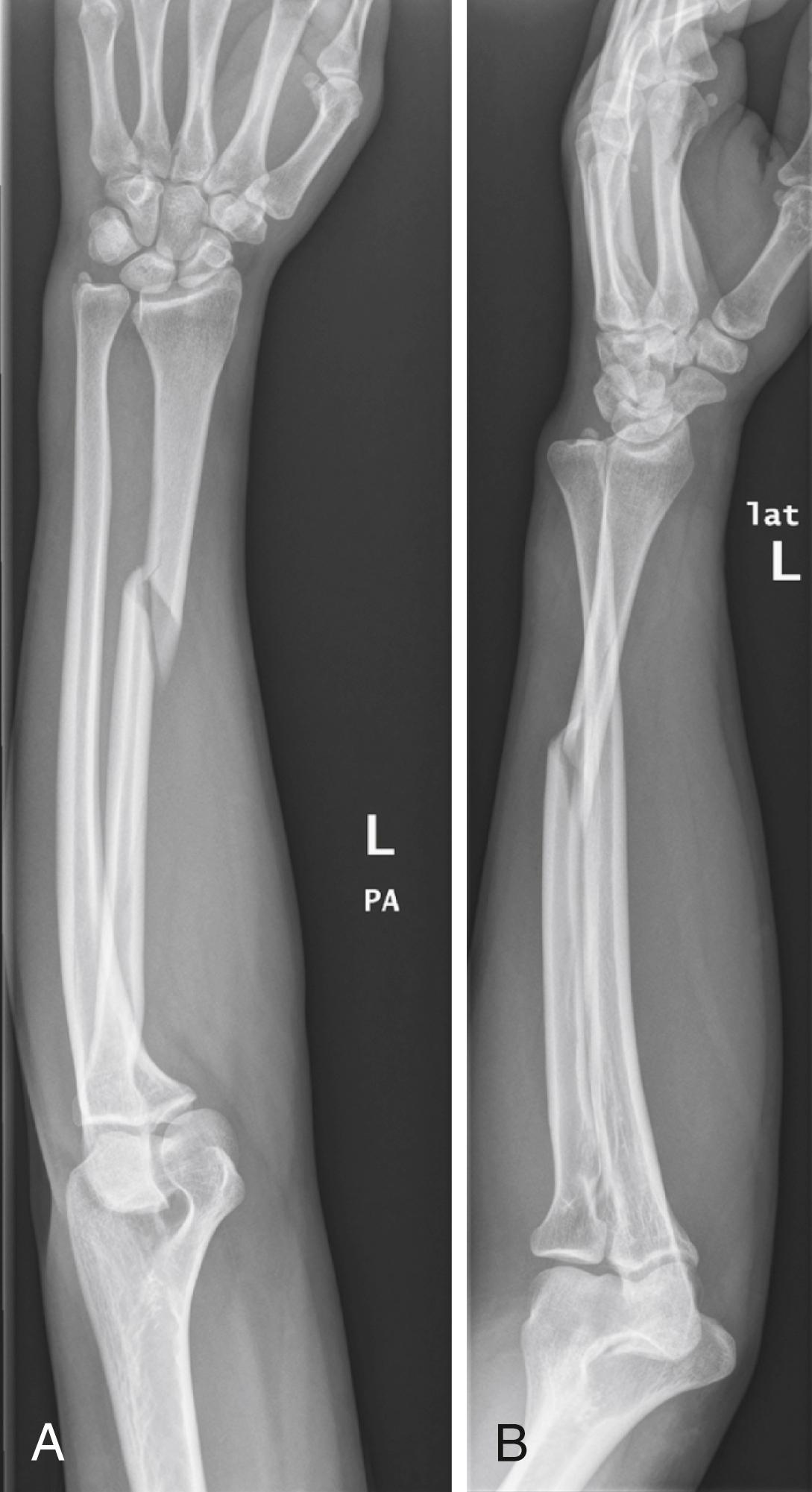
It can be helpful to examine the uninjured wrist to assess the inherent laxity of the patient’s DRUJ. It may also be useful to get radiographs of the uninjured wrist to estimate the patient’s native ulnar variance.
Galeazzi fractures are typically fixed with a 3.5-mm plate placed on the anterior aspect of the radius. The plate needs to be bent distally to accommodate the anterior concavity of the radius at the metadiaphyseal level ( Fig. 21.16 ). Fixation in this region may be more difficult if the fracture is more distal. In this case it is helpful to use a precontoured volar plate designed for distal radius fractures that is sufficiently long to span the fracture proximally.
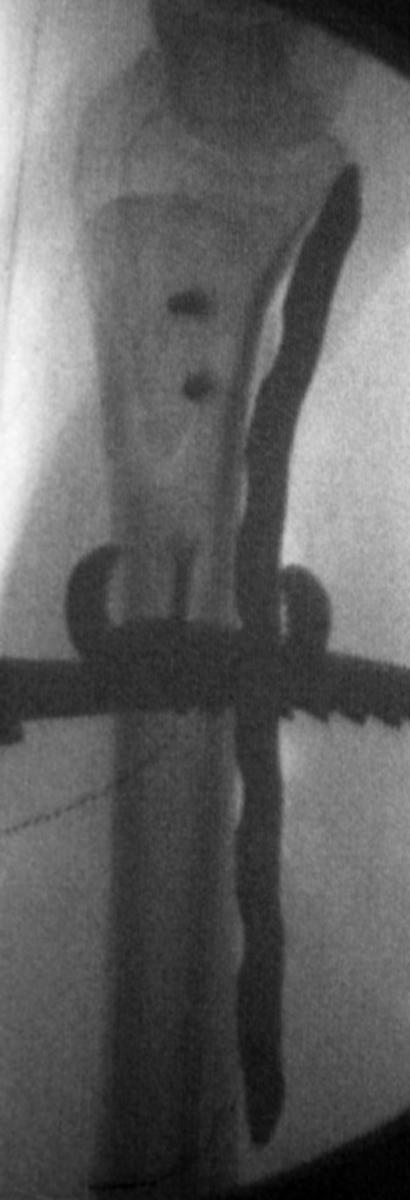
Anatomic reduction of the radius should restore alignment to the DRUJ. If the DRUJ remains unstable or incongruent, the reduction of the radius should be reassessed. If the DRUJ does not reduce, in spite of anatomic reduction of the radius, in rare instances the reduction can be blocked by soft tissue interposition. The extensor carpi ulnaris is a common culprit in this setting. During the operation, one can examine the DRUJ. A “clunk” with passive rotation is evidence of gross instability. Translation of the ulnar head with the forearm in full pronation, neutral rotation, and supination can also be assessed.
If the reduced DRUJ is not stable throughout a full arc of rotation, there are several options. Typically the DRUJ will be more stable in supination and can be immobilized in that position for 3 to 4 weeks. Gross laxity of the DRUJ can be managed with two 0.062-inch smooth Kirschner wires placed proximal to the DRUJ across all four cortices. Having the pin tips exit the radial aspect of the radius and the ulnar aspect of the ulna ensures that all pins can be extracted if the pins break in the interosseous space.
Some surgeons have advocated open or arthroscopic repair of the triangular fibrocartilage complex or open repair of an associated ulnar styloid fracture. In one study, van Duijvenbode and colleagues reviewed the outcome of isolated diaphyseal radius fractures with and without dislocation of the DRUJ. They concluded that anatomic fixation of the radius seemed sufficient without concomitant pinning of the radius to the ulna or repair of the triangular fibrocartilage complex.
The forearm remains the only major diaphyseal segment in which intramedullary fixation is rarely used. Obvious advantages of intramedullary implants in the forearm include minimizing soft tissue stripping, facilitating load sharing, having a low profile design, and reducing the risk of refracture with implant removal. This is particularly true in segmental injuries ( Fig. 21.17 ) and instances where the soft tissues have been compromised by severe contusion or burns. Unfortunately, this technique has been plagued by high rates of nonunion and malunion. There is also a risk of injury to neurovascular structures, especially with proximal locking screws. Locked nails provide increased stability and have union rates that approach or match those of compression plating. ,
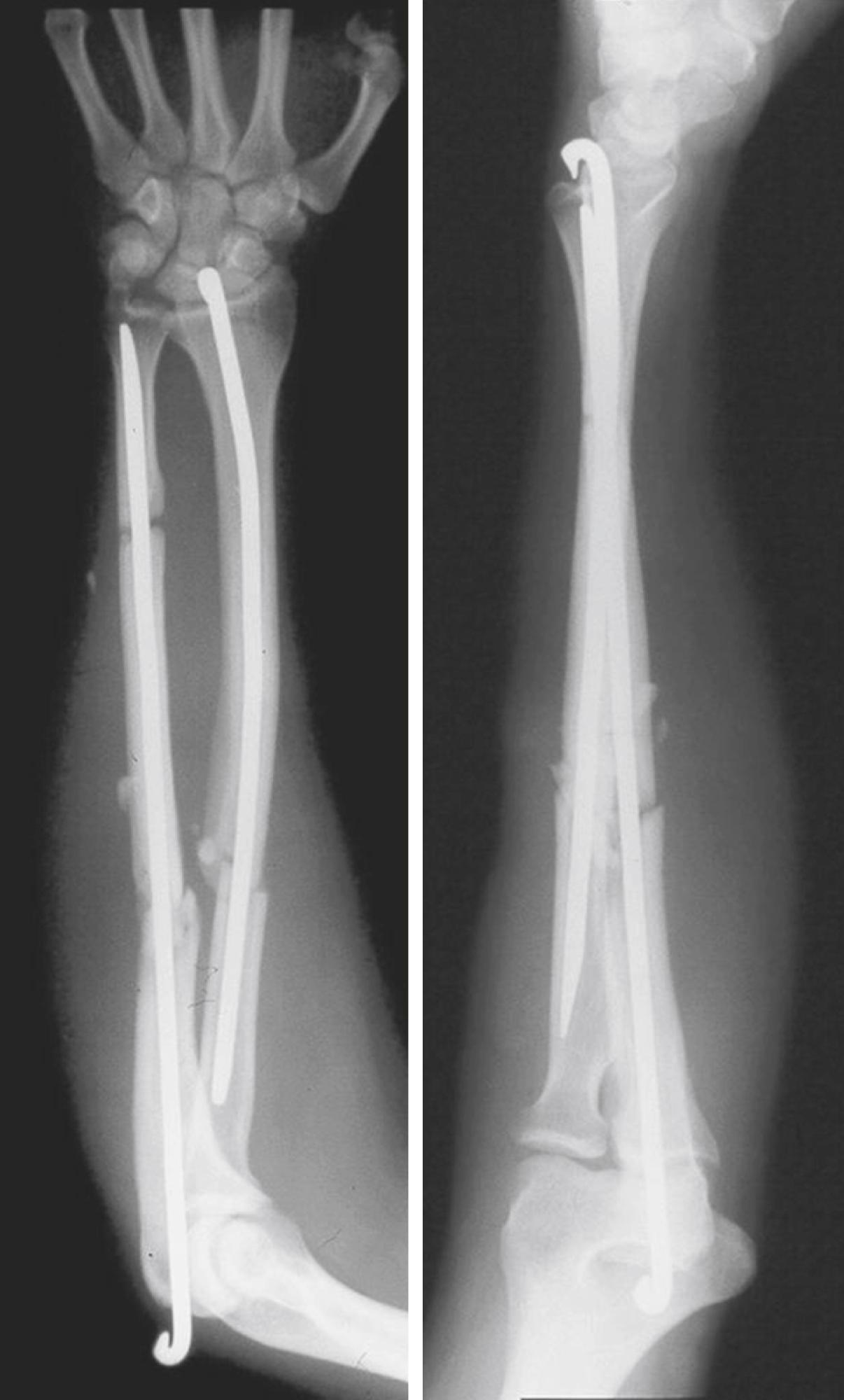
One attractive indication for intramedullary nailing is the management of pathologic fractures. This is particularly true for lesions where the diagnosis is known and treatment consists of bone stabilization followed by irradiation.
The contraindications for nailing of forearm fractures include active infection, previous malunion, canal diameter smaller than that of the available implant, and fracture extension to the metaphysis or articular surface.
The evidence for plate versus nail fixation of adult forearm fractures consists mostly of retrospective reviews of closed radius or ulna fractures and those in which bone grafting is deemed unnecessary. Lee and associates reported their experience in 27 patients with 38 fractures using a contoured, locking intramedullary nail (Acumed, Hillsboro, OR). The nail has a proximal interlocking screw and a “paddle tip” to provide rotational stability. In their series, which included seven open fractures, there was one superficial infection and one nonunion. Five nails (13%) were removed, with no refractures. The average Disabilities of the Arm, Shoulder, and Hand (DASH) score was 15 (range, 5 to 61), with 92% of patients obtaining good or excellent results.
Ozkaya and coworkers retrospectively compared results of treatment in 42 patients with diaphyseal forearm fractures. Twenty-two of the fractures were treated with open reduction and plate fixation, and 20 were treated with closed reduction and locked intramedullary nailing. There was no difference in fracture severity between the groups. Three fractures in the plate group were bone grafted; none were grafted in the nail group. All of the fractures healed. The plates were removed in 12 patients (55%), and the nails were removed in 5 patients (25%). There were no significant differences in outcome.
Visna and colleagues reported the results of a prospective study evaluating 80 patients with 115 forearm fractures treated with either plate or nail fixation. There was one refracture following plate removal. There were two cases of incomplete synostosis and two cases of partial migration of the interlocking screw in the nail group. No significant difference in functional outcome was detected.
External fixation of fractures of the forearm is limited to temporary stabilization of complex forearm injuries and management of segmental defects associated with infection ( Fig. 21.18 ).
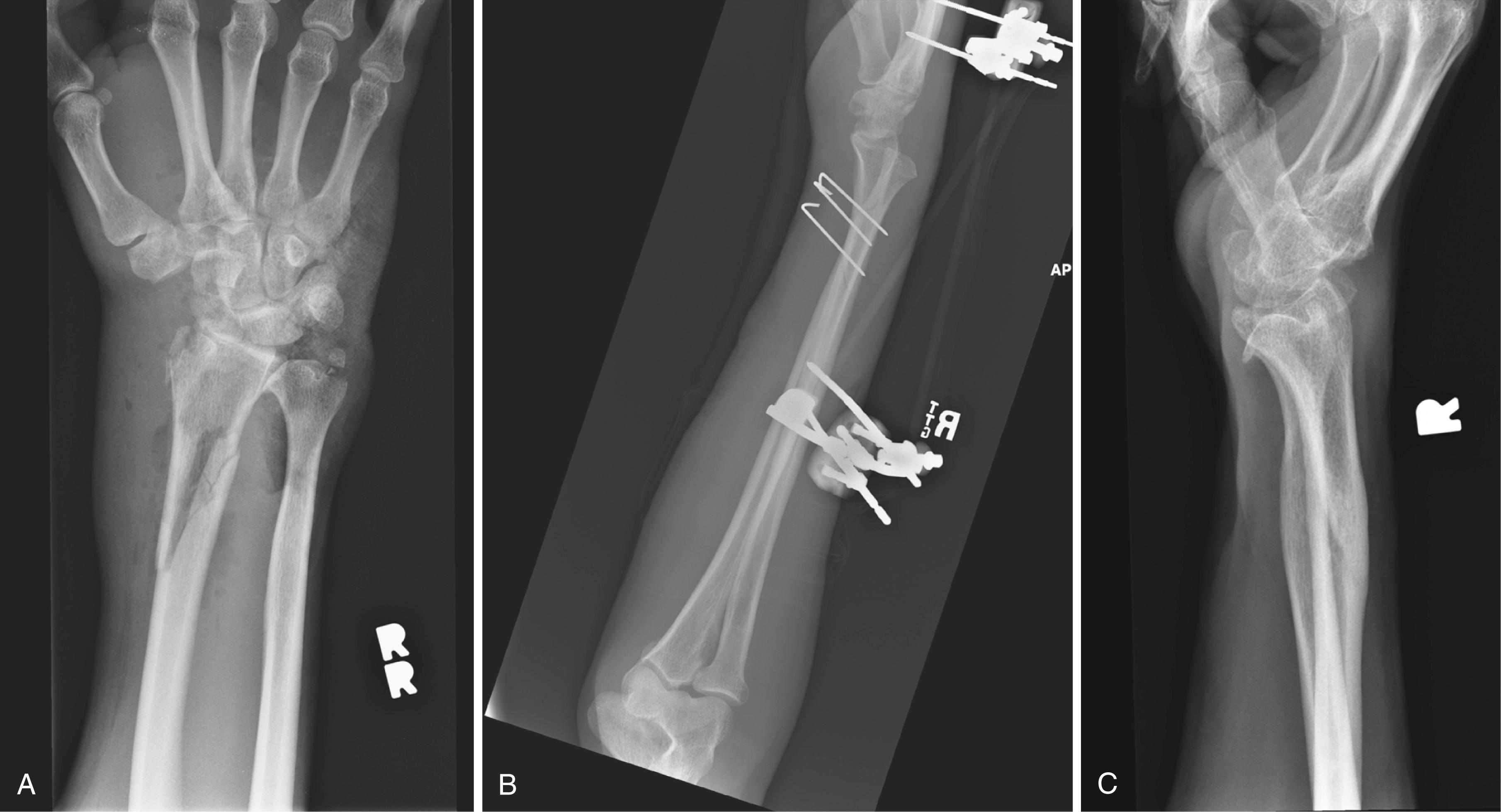
Nonoperative treatment is limited to nondisplaced or minimally displaced or angulated shaft fractures and to patients who are too sick to undergo surgical treatment. However, even nondisplaced diaphyseal fractures can displace in a cast, so nonoperative care requires careful surveillance.
The forearm shaft fracture “tool kit” includes 3.5-mm plates with fracture instrumentation, intraoperative fluoroscopy, and a plan for bone graft if necessary (autograft, allograft, or a bone graft substitute). The anterior approach is used for all fractures of the radius except for proximal fractures involving the radial head and/or neck that extend to the radial tuberosity. In those instances we prefer the Thompson approach. Periosteal elevation is limited to the fracture site. Reduction clamps are used to grasp the shaft of the radius and raise the bone ends sufficiently to clean the fractured surfaces. Spiral and long oblique components of the fracture can be fixed with 2.0-mm or 2.7-mm lag screws and neutralized with a 3.5-mm compression plate. Transverse fractures will often interdigitate and simplify the reduction and stabilization. Short oblique fractures can be “slippery” and therefore more challenging. One can gain control of one end of the fracture by first contouring the plate replicating the radial bow and then securing this to either the proximal or the distal fragment with a single screw. Fluoroscopy is used to confirm reduction, restoration of the radial bow, and hardware position. We still strive to secure six cortices on either side of the fracture ( Fig. 21.19 ).
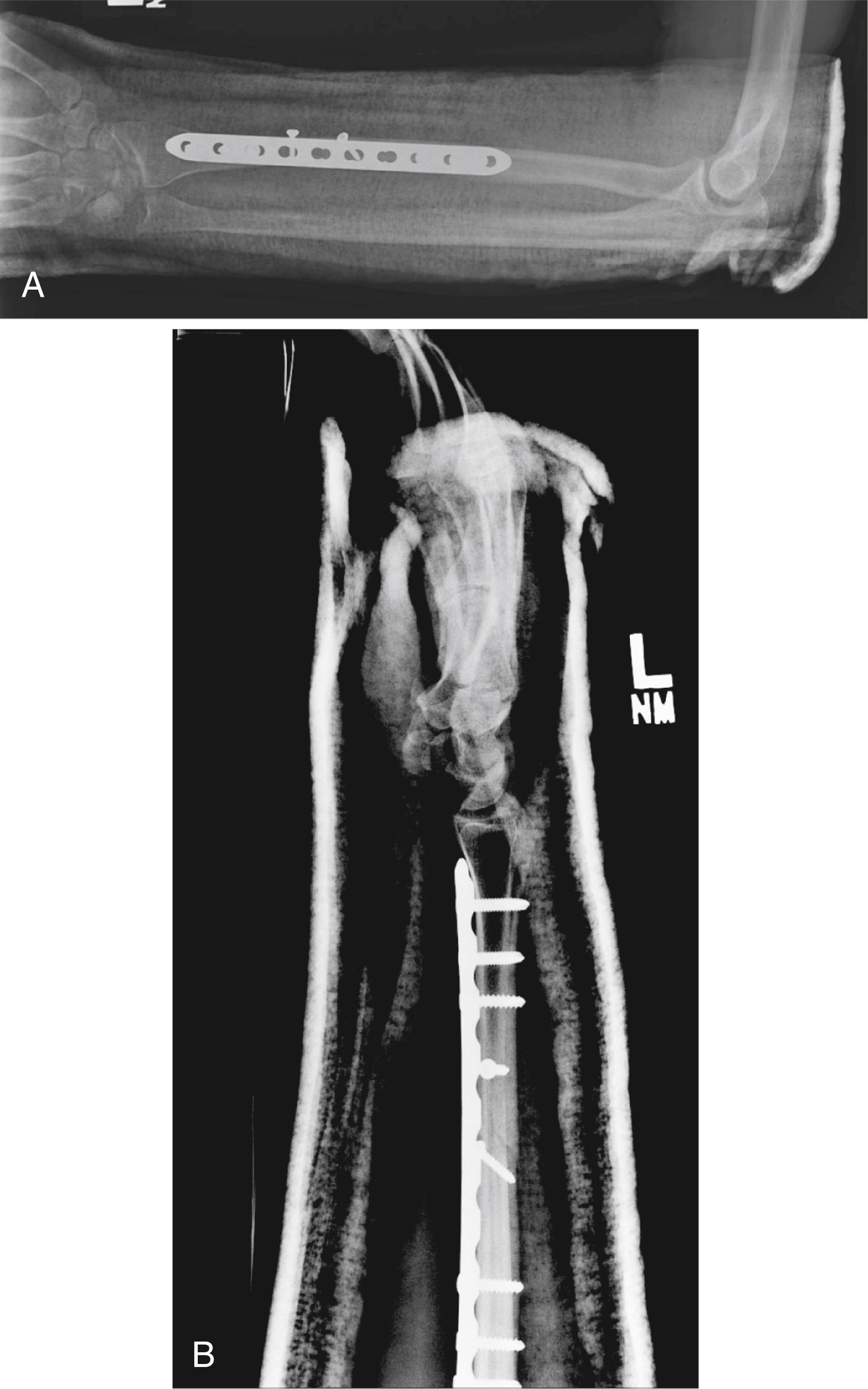
In instances where there is severe comminution, a “bridge plate” can be precontoured to span the defect. It is as important to re-create the correct location of maximal bow as it is to re-create the amount of maximal bow. Transverse or short oblique fractures can usually be fixed with straight plates while maintaining the radial bow. It is considered safe to use a straight plate even if the radial or ulnar edge of the plate is slightly off the bone proximally or distally (as long as the screw purchase is not compromised). Plates used for longer fractures will need to be contoured. In these cases, it may be helpful to have a radiograph of the contralateral, uninjured forearm. Rotational alignment of the radius can be checked by comparing the proximal bicipital tuberosity with the distal radial styloid on a fully supinated radiograph. With an anatomic reduction, the tuberosity and styloid should be seen in profile and facing in opposite directions, that is, ulnarly and radially, respectively. With more distal shaft fractures, an anterior bend may need to be placed in the plate to match the anterior flare of the radius in the metadiaphyseal region (see Fig. 21.16 ). The best way to ensure re-creation of an adequate radial bow and restoration of appropriate rotational and angular alignment is to check passive rotation after provisional fixation. With full forearm rotation, it is likely that near-normal relationships have been restored.
As mentioned above, the role of bone grafting is somewhat controversial. We use bone grafting in fractures in which contact at the fracture site is 50% or less. Most commonly, cancellous autograft is harvested from either the iliac crest or the proximal tibia. The olecranon process of the ulna and the distal radius (in proximal fractures) are other options. Compressed cancellous autograft is also used for significant gaps with stable fixation. If fracture fixation is tenuous, intercalary corticocancellous grafting using the iliac crest can be considered to augment stability. Locking plates are useful in this setting and may obviate the need for structural bone graft.
Maintain a superficial interval between the brachioradialis and radial artery/flexor carpi radialis.
Protect the dorsoradial sensory nerve beneath the brachioradialis.
The deep interval is dependent on the proximal-distal level of the fracture.
Use interfragmentary compression techniques (lag screws or compression plating, or both) when possible.
Use intraoperative fluoroscopy to confirm adequate reduction and hardware placement.
Ensure adequate passive pronation-supination after reduction and provisional fixation.
Hand stiffness and loss of forearm supination are among the most common complications of forearm trauma. A nonconstrictive dressing will help facilitate free finger motion. Immediate forearm rotation should be possible in most cases after fixation. Immobilization is typically limited to short-arm immobilization in a lightweight splint for comfort and support. Weight bearing, strengthening, and static progressive splinting are deferred until there is radiographic evidence of union. Long-arm immobilization for approximately 4 weeks is typical for patients with a Galeazzi fracture when there is instability of the DRUJ. These patients are given a short-arm splint for 2 weeks thereafter and closely monitored for residual instability.
Union rates for uncomplicated radial shaft fractures are in excess of 95%. , Morrey and associates defined the functional arc of forearm rotation as 50 degrees of supination and 50 degrees of pronation. This should be easily achievable in most shaft fractures. Ultimate forearm rotation will vary with the severity of the associated soft tissue injury and the time to union. Droll and coworkers noted a “moderate reduction” in the strength of the forearm, wrist, and hand.
Near-anatomic reduction with stable fixation
Greater than 95% union rates
Excellent hand motion and a functional arc of forearm rotation
Mild to moderate loss of forearm strength
Most of the untoward consequences of forearm shaft fractures are the result of soft tissue damage from the energy dissipated by the injury. In its wake lie damaged muscles, bruised or cut tendons, damaged nerves, and a swollen limb. Appropriate treatment can minimize but not eliminate the effects of this initial insult to the arm. Higher-energy injuries carry higher risks of nonunion, malunion, and residual stiffness.
Isolated distal and midshaft ulnar fractures are most often a result of direct trauma. Be wary of associated injuries to the wrist, forearm, and elbow. In isolation, the so-called nightstick fracture follows a blow to the subcutaneous border of the ulna. Closed distal and midshaft ulnar fractures can be treated successfully with nonoperative methods, such as functional bracing or short-arm casting, when the displacement or angulation is minimal. A Cochrane review included three trials comparing various methods of nonoperative treatment for isolated diaphyseal fractures of the middle and distal thirds of the ulna in adults. The review concluded that there was no evidence that immobilization of the elbow provided short-term benefit in terms of pain relief or fracture union compared with casts or braces that immobilized only the forearm. Van Leemput and Mahieu reviewed a total of 102 patients who were treated with a compression bandage (n = 34), a short-arm cast for 6 weeks (n = 36), or a long-arm cast for 3 weeks followed by a short-arm cast for 3 additional weeks (n = 32). At 12 weeks of follow-up, there was no significant difference in the incidence of delayed union, time to fracture union, mean pain scores, or range of motion among the three groups.
The ideal treatment of these fractures, regardless of the degree of displacement, has yet to be determined. Displaced fractures with more than 10 degrees of angulation or 50% displacement are considered candidates for operative treatment. , It has been suggested that displacement of more than 50% indicates that at least partial disruption of the IOM is present. ,
The ulna is the stable post of the forearm. The radius rotates about the ulna to allow a functional arc of forearm rotation. In the distal and midshaft portions, the ulna is essentially straight. The midshaft region has a narrow apex adjacent to the subcutaneous border, which makes direct ulnar placement of a plate more difficult. The ulna is triangular through most of the diaphysis, with a sharp radial border serving as the origin of the interosseous ligament. This morphologic picture affords a relatively flat volar surface where the ulna is also relatively wide, making it well suited for longitudinal implants. Volar placement also provides better soft tissue coverage, better matching of the undersurface plate structure with the underlying bone structure, and, theoretically, minimization of the need for future plate removal due to plate prominence.
The ulnar nerve and artery lie deep to the flexor carpi ulnaris muscle belly in the proximal part of the forearm and are radial and deep to its tendon. The dorsoulnar sensory nerve may exit the deep forearm fascia anywhere from 1 to 4 cm proximal to the ulnar styloid. It courses though the “ulnar snuffbox” in a proximal volar to distal dorsal direction ( Fig. 21.20 ).
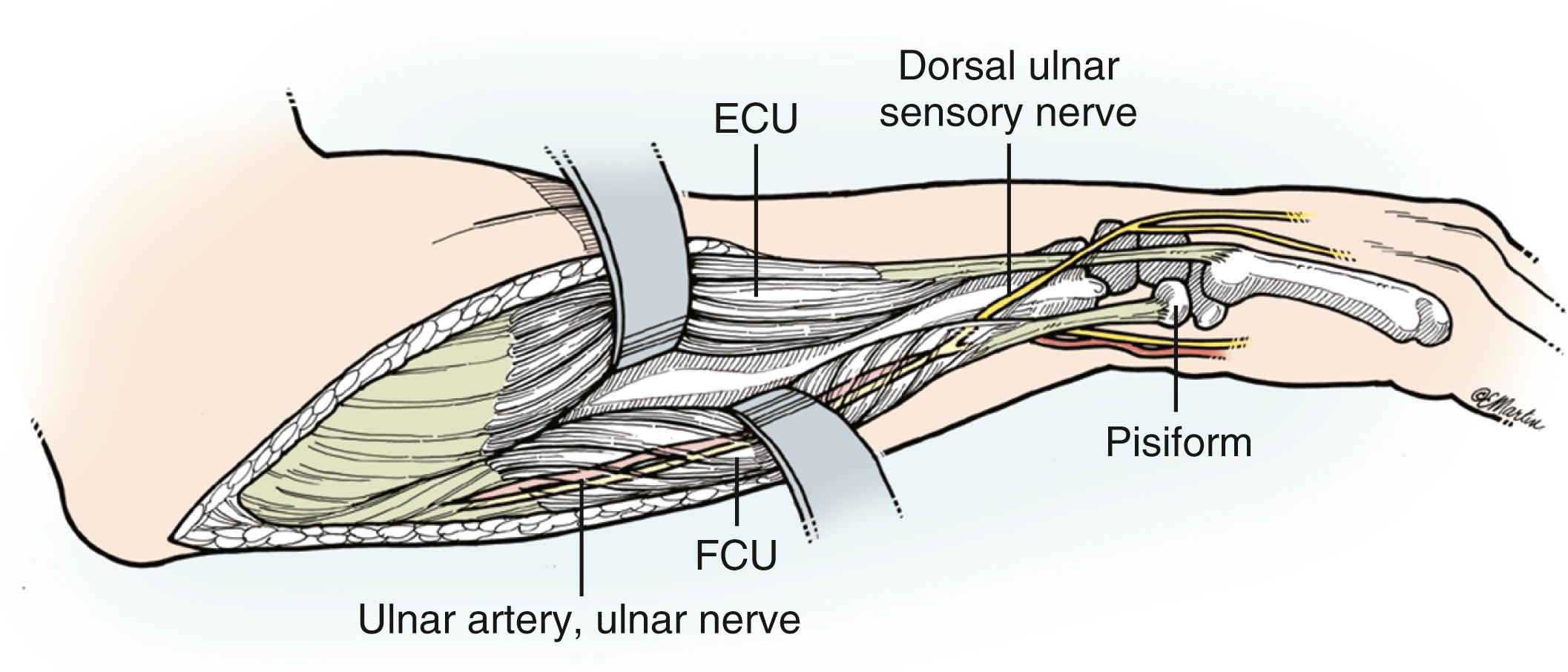
Become a Clinical Tree membership for Full access and enjoy Unlimited articles
If you are a member. Log in here